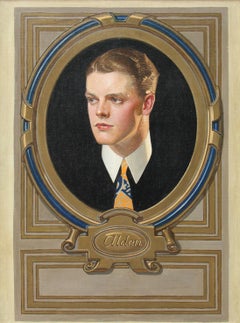Leyendecker Arrow
1920s Portrait Paintings
Canvas, Oil, Board
1940s Figurative Paintings
Canvas, Oil
People Also Browsed
Antique Late 18th Century Italian Paintings
Canvas, Wood, Paint
Early 20th Century Desk Sets
Gold
Antique 1880s Swiss Animal Sculptures
Walnut
Early 20th Century French Art Deco Club Chairs
Ash, Upholstery
Antique Mid-19th Century English Anglo-Japanese Decorative Dishes and Vi...
Paper, Paint
20th Century American Art Deco Table Clocks and Desk Clocks
Enamel
Antique Late 19th Century English Late Victorian Sterling Silver
Silver, Sterling Silver
Early 20th Century American American Colonial Tea Sets
Sterling Silver
Early 20th Century French Trunks and Luggage
Brass
Antique 15th Century and Earlier German Decorative Art
Other
20th Century German Art Nouveau Animal Sculptures
Bronze
Antique Late 19th Century Brazilian Romantic Chaise Longues
Wood
Antique Late 19th Century Persian Kashan Persian Rugs
Wool, Kork
Antique Late 19th Century Swiss Black Forest Cigar Boxes and Humidors
Fruitwood
Antique 19th Century German Black Forest Side Chairs
Walnut
Antique 19th Century English Regency Sheffield and Silverplate
Sheffield Plate
Leyendecker Arrow For Sale on 1stDibs
How Much is a Leyendecker Arrow?
Joseph Christian Leyendecker for sale on 1stDibs
Joseph Christian "J.C." Leyendecker was born in Germany in 1874. He immigrated to the United States with his family in 1882. His eldest brother, Adolph, became a prominent stained glass artist, and Joe, as he was called, had an early artistic calling.
After studying at the Chicago Art Institute under John H. Vanderpoel, J.C. Leyendecker enrolled at the Académie Julien in 1896, where he studied for a year with his younger brother Frank in the Beaux-Arts tradition. During his time there, he was exposed to and influenced by the works of Art Nouveau painters and printmakers Henri de Toulouse-Lautrec, Jules Chéret and Alphonse Mucha, with whom he formed a strong friendship. The next year, he staged his first one-man exhibition at the Salon du Champ-de-Mars and made the auspicious acquaintance of Paul Gauguin.
In 1898, Leyendecker produced the first of 48 covers for Collier’s magazine. The next year, he painted his first cover for The Saturday Evening Post magazine, which was the beginning of a 44-year association with that esteemed publication. Throughout his career, he would also paint covers for Life magazine, illustrations for a library of books, and transform advertising for such companies as B. Kuppenheimer & Co. and Interwoven Socks. His work for Arrow Shirt is the most well-known and beloved.
Using his lover and manager, Charles Beach, as a model, Leyendecker created the ultimate image of modern American masculinity. His work for Kuppenheimer, also known as the House of Kuppenheimer, is just as iconic. Founded in 1876, the company became the manufacturer of uniforms for the United States Army during World War I. Thanks to Leyendecker's advertising, the firm became synonymous with the ultimate in male taste and desirability.
Unfortunately, near the end of his career, as Leyendecker’s associations with Collier’s and The Saturday Evening Post came to an end, his work fell into obscurity. When he died in 1951, his great friend Norman Rockwell, who commemorated their relationship in his painting Waiting for the Art Editor, served as one of his pallbearers.
Find original J.C. Leyendecker prints and paintings on 1stDibs.
(Biography provided by M.S. Rau)
Finding the Right Paintings for You
Painting is an art form that has spanned innumerable cultures, with artists using the medium to tell stories, explore and communicate ideas and express themselves. To bring abstract paintings, landscape paintings, still-life paintings and other original paintings into your home is to celebrate and share in the long tradition of this discipline.
When we look at paintings, particularly those that originated in the past, we learn about history, other cultures and countries of the world. Like every other work of art, paintings — whether they are contemporary creations or works that were made during the 19th century — can often help us clearly see and understand the world around us in a meaningful and interesting way.
Cave walls were the canvases for what were arguably the world’s first landscape paintings, which depict natural scenery through art. Portrait paintings and drawings, which, along with sculpture, were how someone’s appearance was recorded prior to the advent of photography, are at least as old as Ancient Egypt. In the Netherlands, landscapes were a major theme for painters as early as the 1500s. Later, artists in Greece, Rome and elsewhere created vast wall paintings to decorate stately homes, churches and tombs.
Today, creating a wall of art is a wonderful way to enhance your space, showcase beautiful pieces and tie an interior design together.
No matter your preference, whether you favor Post-Impressionist paintings, animal paintings, Surrealism, Pop art or another movement or specific period, arranging art on a blank wall allows you to evoke emotions in a room while also showing off your tastes and interests. A symmetrical wall arrangement may comprise a grid of four to six pieces or, for an odd number of works, a horizontal row. Asymmetrical arrangements, which may be small clusters of art or large, salon-style gallery walls, have a more collected and eclectic feel.
Download the 1stDibs app, which includes a handy “View on Wall” feature that allows you to see how a particular artwork will look on a particular wall, and read about how to arrange wall art. And if you’re searching for the perfect palette for your interior design project, what better place to turn than to the art world’s masters of color?
On 1stDibs, you’ll find an expansive collection of paintings and other fine art for your home or office. Browse abstract paintings, portrait paintings, paintings by emerging artists and more today.

